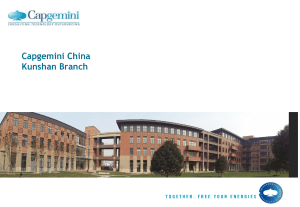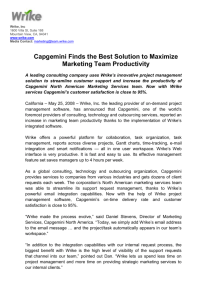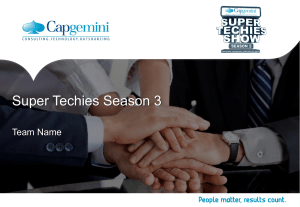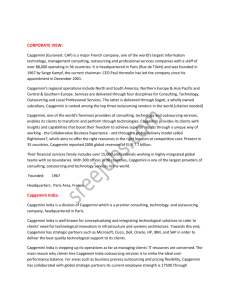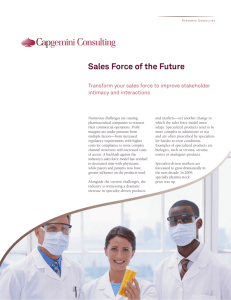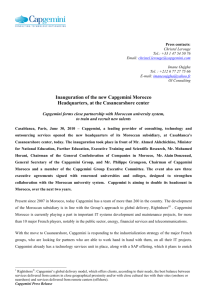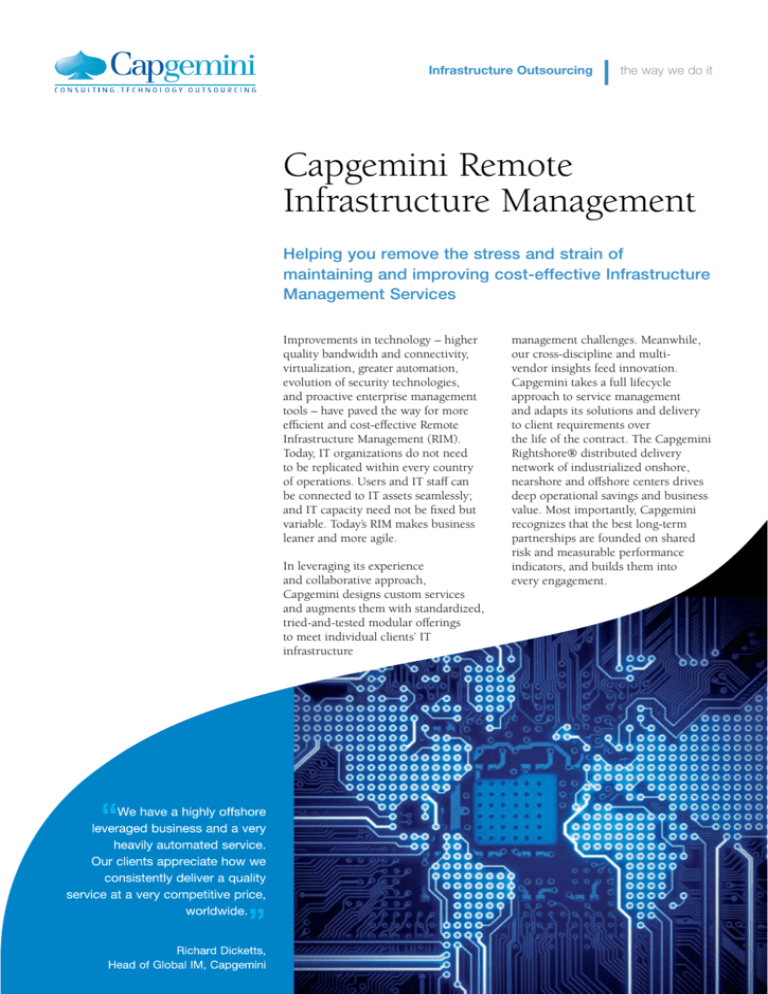
Infrastructure Outsourcing
the way we do it
Capgemini Remote
Infrastructure Management
Helping you remove the stress and strain of
maintaining and improving cost-effective Infrastructure
Management Services
Improvements in technology – higher
quality bandwidth and connectivity,
virtualization, greater automation,
evolution of security technologies,
and proactive enterprise management
tools – have paved the way for more
efficient and cost-effective Remote
Infrastructure Management (RIM).
Today, IT organizations do not need
to be replicated within every country
of operations. Users and IT staff can
be connected to IT assets seamlessly;
and IT capacity need not be fixed but
variable. Today’s RIM makes business
leaner and more agile.
In leveraging its experience
and collaborative approach,
Capgemini designs custom services
and augments them with standardized,
tried-and-tested modular offerings
to meet individual clients’ IT
infrastructure
management challenges. Meanwhile,
our cross-discipline and multivendor insights feed innovation.
Capgemini takes a full lifecycle
approach to service management
and adapts its solutions and delivery
to client requirements over
the life of the contract. The Capgemini
Rightshore® distributed delivery
network of industrialized onshore,
nearshore and offshore centers drives
deep operational savings and business
value. Most importantly, Capgemini
recognizes that the best long-term
partnerships are founded on shared
risk and measurable performance
indicators, and builds them into
every engagement.
Why Remote Infrastructure
Management?
Global enterprises must reduce
IT spending in order to remain
competitive. CIOs have to redress
the mounting costs of space,
power, and skilled staff. To this
end, RIM improves on traditional
infrastructure delivery because it
lowers operational costs, by at least
30%; and, by leveraging Capgemini’s
RIM model up-front, costs are
minimized. Balanced onshore/offshore
delivery brings labor cost savings;
productivity gains are realized through
industrialization and productization.
In addition to its ability to release
immediate savings, Capgemini’s
Remote Infrastructure Management
assures process improvement. Access
to best-in-class tools and technical
expertise as well as integrated
processes and methodologies
drives optimal service structuring
and continuous improvements. Service
levels are clear and visible, consistent
and predictable.
IMOC: Capgemini RIM headquarters
For most clients, Capgemini takes an operation that works and makes it work
better at a lower cost. At the heart of our RIM services is the Infrastructure
Management Operations Center (IMOC) operated globally along our
Rightshore® network. The IMOC is a control room which provides
comprehensive displays of the health and status of the infrastructure
and networks.
Our IMOC model not only guarantees 24x7 operational monitoring, 1st line
support and problem escalation, it also delivers 2nd line support, base-level
tech support, automation, and client liaison. Persons who are part of IMOC
leadership, management and high-end service support functions look at more
complex issues to add value and re-engineer clients’ services.
Capgemini’s Infrastructure Management Operations Center guarantees:
Reduced management overhead,
Integrated tools to manage network and server monitoring and security,
One team shift-left approach to combine knowledge management with
problem, change and incident management and to improve implemented
processes and procedures,
Fully integrated ITIL processes for operational efficiency, combined with
service level & availability management.
RIM also guarantees lower risk of
IT failure thanks to a global delivery
network and improved infrastructure
availability, 24x7 proactive, followthe-sun monitoring. Meanwhile,
world-class proactive governance
and contractual performance
measurement targets yield consistent,
ever-improving processes and delivery.
Yet, Remote Infrastructure
Management is not just a way
to keep the lights on for less. The
RIM decision should be taken within
the context of the longer-term
business strategy. RIM drives ITand-business alignment and instils
agility through faster and more flexible
IT provisioning. It can also act as
a lever for continuous improvement
and innovation.
The IMOC is setup onshore, nearshore or offshore – to best suit your needs
Why Capgemini RIM?
Capgemini RIM builds on our
40+ years experience as a global
leader in consulting, technology
and outsourcing services.
A record of over a thousand
successful transitions – Capgemini’s
transition process is focused on
speed, cost, and effectiveness
without disruption to services.
Rightshore® delivery network
and follow-the-sun command
model, key to optimizing costing
and capabilities and to significant
multilingual capabilities – we serve
our clients in 35 languages.
Integrated governance and service
management for process maturity
excellence, ISO 9001:2000
and ITIL3 aligned – for business
and IT alignment.
RIM is part of comprehensive
end-to-end offering and is also
available as a standalone solution.
Shift-left strategy – for greater
pro-active intervention
and the right innovations.
End-to-end collaborative business
experience for integrated
knowledge sharing, ecosystem
management and commercial
flexibility – willingness
to be measured against business
performance.
Vendor-neutral philosophy – we
can assist regardless of client’s
vendor specificity and are not
limited in what technology
solutions we can propose.
Clear and flexible contract
and utility-based pricing – so costs
match business demands.
Infrastructure Outsourcing
the way we do it
Capgemini RIM for Genuine Collaboration
A global building and packaging leader with operations supported by
200,000 employees spanning 49 countries and yielding yearly revenues
of €41,000m, had 2,100 IT staff grouped into around 300 separate teams
working in 5,000 locations and 1,500 data rooms with around 8,300
servers and 95,000 PCs. It decided to find a partner with global experience
and expertise to help consolidate its IT operations and implement consistent,
high quality and business-value-adding IT processes and tools.
It chose Capgemini. Through numerous collaborative workshops, a detailed
transition plan was developed, tailored to each complex environment
to minimize disruption to the client’s business through transition. A strong
governance structure with local domain expertise was established for optimal
joint responsibility.
For enhanced financial savings and seamlessness of operations,
the collaboration backbone was strengthened with the right blend of onshore
and offshore services. This made it possible to consolidate workloads into
two twin locations (4 data centers) and to deliver follow-the-sun command
and support services from Capgemini’s Mumbai center.
Upon a closer look at the client’s operations, Capgemini also offered several
innovative transformational solutions: an enhanced Disaster Recovery
Planning solution delivered exploiting Capgemini’s secured dual-site data
centers; on-demand facilities for storage and backup, aligned to a utilitybased pricing model; and Aix consolidation and virtualization through
the consolidation of Aix applications to be run on servers split over dual-site
data centers.
Thanks to a flexible contract with utility-based pricing, client costs
now match business demands. KPIs based on user satisfaction illustrate
Capgemini’s confidence in its solution and in the co-developed transition
plan; in addition, they are a testament to our willingness to be measured
against business performance.
Capgemini’s RIM Value Proposition
RIM Market Trends
Considering RIM for your enterprise?
You are not alone.
About Capgemini and the
Collaborative Business ExperienceTM
Experts have been up-revising their
forecasts for the development of
the market of RIM services. Currently,
the consensus is that it will grow
at 20-30% annually as global IT
service providers ramp up their
delivery capabilities and CIOs look
to cut infrastructure costs. According
to a recent article about the pros
and cons of offshore RIM published
online at www.cio.com, approximately
70% to 80% of vendor IT outsourcing
proposals hitting the market contain
some form of offshore infrastructure
delivery of services.1
revenues of EUR 8.7 billion and employs over
92,000 people worldwide.
Capgemini Outsourcing Services (OS)
draws on the expertise of more than
25,000 employees to manage, innovate
and improve the IT systems and business
processes of its clients. Capgemini OS
offers a full spectrum of services including
Applications Outsourcing, Infrastructure
Outsourcing, Business Process Outsourcing
and Transformational Outsourcing.
More information is available at
www.capgemini.com/services/outsourcing
For further information on Remote Infrastructure Management, you can contact:
Capgemini Outsourcing B.V.
Papendorpseweg 100
Postbus 2575 – 3500 GN Utrecht
The Netherlands
Erick Schabracq
Product Marketing Netherlands
+31 6 150 30 766
erick.schabracq@capgemini.com
1
CXO Media Inc.: Outsourcing: The Pros and Cons of Offshore Remote Infrastructure Management, Stephanie Overby, 18
March 2008 (http://www.cio.com/article/198450/Outsourcing_The_Pros_and_Cons_of_Offshore_Remote_Infrastructure_
Management?page=1)
2
Gartner Inc.: MarketScope for Remote Monitor Services (Global), Richard T. Matlus, William Maurer, Frank Ridder, Gianluca
Tramacere, Claudio Da Rold, Jim Longwood, Eric Goodness, 21 October 2008.
MarketScope Disclaimer: The MarketScope is copyrighted 21 October 2008 by Gartner, Inc. and is reused with permission. The
MarketScope is an evaluation of a marketplace at and for a specific time period. It depicts Gartner’s analysis of how certain
vendors measure against criteria for that marketplace, as defined by Gartner. Gartner does not endorse any vendor, product or
service depicted in the MarketScope, and does not advise technology users to select only those vendors with the highest rating.
Gartner disclaims all warranties, express or implied, with respect to this research, including any warranties of merchantability
or fitness for a particular purpose.
3
Forrester Inc.: The Forrester Wave™: Global IT Infrastructure Outsourcing, Q1 2009, Paul Roehrig, 6 April 2009.
Copyright ©2010 Capgemini. All rights reserved.
2009.06.04_EDGE
Analysts Recognize Capgemini
RIM Services
Capgemini’s Remote Infrastructure
Management services continue
to receive recognition from major
analyst firms. Capgemini received
a positive rating for remote monitoring
services in Gartner’s report entitled
“MarketScope for Remote Monitor
Services (Global).”2 Moreover,
Capgemini was positioned as
a leader for Global IT Infrastructure
Outsourcing in Forrester’s report,
The Forrester Wave™: Global IT
Infrastructure Outsourcing, Q1 2009
for its “particularly strong […] story
on innovation for services clients”
and “solid, well-funded, forwardlooking strategy for the infrastructure
business, particularly in the future
of cloud/utility-based services via
budding partnerships with Google
and Amazon.”3
Capgemini, one of the world’s
foremost providers of consulting, technology
and outsourcing services, enables its
clients to transform and perform through
technologies. Capgemini provides its clients
with insights and capabilities that boost their
freedom to achieve superior results through
a unique way of working, the Collaborative
Business Experience™. The Group relies on
its global delivery model called Rightshore®,
which aims to get the right balance of the best
talent from multiple locations, working as
one team to create and deliver the optimum
solution for clients. Present in more than 30
countries, Capgemini reported 2008 global

